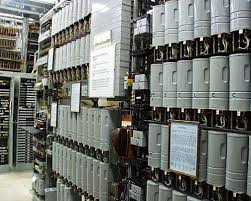I have written about several people that have given us technologies we take for granted. Seeing my electronic post bag bursting at the seams, I thought I would write about another. I bet you are trembling with anticipation.
We all take ringing someone up for granted. It wasn’t long ago, 1920s, that you would pick up the phone, to be answered in person by a polite lady, asking with whom you would like to be connected. This new fangled telephone network was developing at a pace, with overhead cables littering the skyline. Picking up your receiver would complete an electrical circuit and operate an electro mechanical flap, “dolls eye” at the telephone exchange to attract the attention of the “operator”. In the early days, this “exchange” may well have been in a private house or in a back room of a local shop. She would ask you who you wanted to speak with, manually connecting you to that subscriber. She would connect a jack lead into the socket on the switchboard, turn a handle which would generate a ringing current to sound the bell at the other end. When the receiving party answered, she would link the two parties together. She would then listen into the call and clear the line down when you stopped talking.
Now, history has it, that Mr. Strowger, an Undertaker by trade, had the right hump with the girl at his local telephone exchange. He knew she would listen to his calls and pass pending business to her husband, a competing Undertaker. Awful. He set about designing the principles of an automatic system which could connect telephone users together, without the human element. He enlisted the help of his brother-in-law who was an electrical engineer. A system of pegs set in a circle were connected to a central relay system. A specific sequence of peg operation connected you to the required other user. This system, that now had a patent, was installed in Strowger’s then home town in India, in 1891. “The Automatic Electric Exchange Company” was established. Strowger sold his shares and patents in 1898 for about $2000. They sold for $2.4 million in 1916! Bugger!
The system developed quickly and in the UK, the British Post Office trialed several systems around the country from different manufactures, from Sweden, Germany and the US, Mr. Strowger, won.
The system developed into the “two motion” switch. You will be familiar with the dial telephone. Lift the handset and this enables a relay system in the exchange to get ready for your call. As you wound up the spring-loaded dial and released it, it would wind back at a regulated speed, sending a chain of pulses (10 per second) to the exchange. 1 pulse for digit 1, through to 10 pulses for digit 0. The pulse was generated by closing and opening the circuit, simple. This would step a “selector relay” at the exchange to a routing path awaiting your next digit of the number to be dialed. The time it took you to wind the dial round to the next digit and then released would be detected at the exchange by a relay that would drop out after a second or so. With each digit dialed, a different selector would take you to the next part of the route. Eventually, when all digits were dialed, a “ringing current” would be sent to the distant phone, to ring it’s bell. The subscriber would pick up the handset, which would finalise the electrical connection between caller and receiver at the exchange. The basics were quite simple, but there was quite a bit going on to support a reasonable standard of audio. One example would be the hybrid transformer in each telephone which enabled the user to hear a little bit of their own voice, giving them the confidence that the line is “live”. The answering party would politely announce themselves as the name of the local exchange and your number. E.g. “Temple Bar 3658”, as opposed to a rather abrupt “speak to me” that you would hear in Spain. The exchange would detect if the distant handset was ready to receive a call and not busy. If it was in use, a busy tone would be sent to the caller.
The electro-mechanical Strowger system stayed in service in the UK until well into the 1980s. This included the talking clock, which was recorded onto a large rotating multi segment drum, containing all the separate words to be linked together to make up the Time is sentence. “Dial Tone and “Engage Tones” were recorded on a similar drum. There is a separate article on this on my site should you wish to read on. The speaking clock latterly dial a disc, weather report numbers could be dialed. These were added to encourage people to use the system.
As time progressed, STD (subscriber trunk dialing) developed which allowed you to make calls to different towns up and down the country without asking an operator to connect you. The number of links between exchanges were limited. In “Times of Crisis”, telephone access would be restricted to police and doctors.
Interesting fact… An electro-mechanical system is far less prone to damage by an “EMP”, Electro Magnetic Pulse, generated by a nuclear bomb. The EMP would trash any modern day electronic system. An old Strowger system, under Downing Street, is currently maintained, just for that reason. Well certainly was when I was a telecoms engineer in the `80s. Top Secret! If I told you any more, I would have to shoot you.



